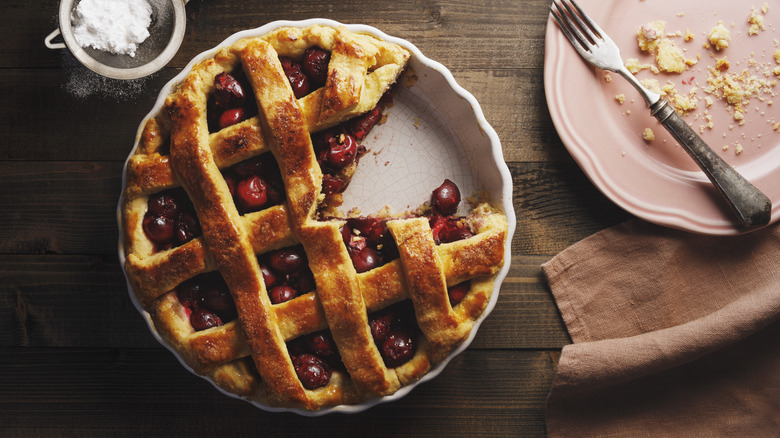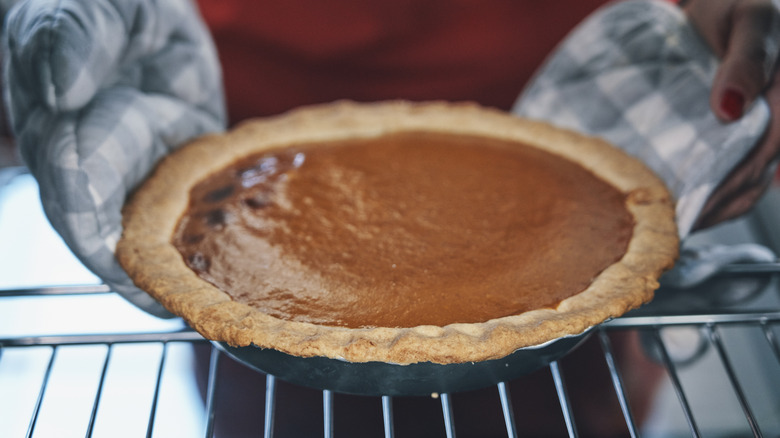Common Pie Crust Mistakes To Avoid, According To An Expert
Baking a pie is a rewardingly delicious feat, but mastering the pastry can be a challenging process. Luckily, baking experts are here to save us from a laundry list of pie-making mistakes. When it comes to pie crust, Sarah Fennel, baker and founder of the blog Broma Bakery, sheds some light on common pitfalls (and how to avoid them) that lead to tough and overbaked crusts.
One mistake novice pie bakers make is letting the raw pie crust come to room temperature, which can ruin its flaky texture. "Make sure to refrigerate your pie crust before baking it off," Sarah Fennel says. "Room temperature pie crust won't keep its shape in your oven, and won't lead to as flaky a crust, as the room temperature butter melts more into the flour."
Though it may seem like a small consideration, keeping your flaky pie crust dough cold is key. In the heat of the oven, cold butter bits in the dough release steam, creating airy openings between layers of starch and fat. If you let the pie dough sit out and come to room temp, the butter will leak and melt quickly, resulting in a tough crust without these tender, flaky layers. To keep the butter bits intact and cold, Sarah Fennel recommends a necessary chilling step. She says, "Just 30 minutes in the fridge (or 15 minutes in the freezer) will do the trick!"
Take your filling's moisture content into consideration
After you've made your pie crust dough, there couldn't be too much else that could go wrong ... right? Actually, think again — especially when it comes to fruit pies with moist fillings. Sarah Fennel explains that you have to think about the water content in your fruit. She says. "The higher the water content in your fruit, the longer it's going to take to evaporate out of your pie, which — if you're not careful — can lead to an overcooked crust and undercooked filling in your pie."
To help prevent this, you can cook down a portion of your fruit before adding it to the crust to bake. "Cooking down half of your fruit helps to remove some of that pesky water content, and starts the 'jamming' process of your fruit," Fennel says. This should also help keep your filling from boiling over or seeping into your pie crust.
You can also par-bake or blind-bake pie crust which should help it stand up against excess moisture and prevent against a soggy bottom. After the crust has blind-baked, brush it with a light layer of whisked egg whites to create a seal. This will keep your pie crust intact and prevent excess moisture from altering its flaky texture. You'll have to be careful though, par-baking your crust will make it more robust, but it could lead to over-browning or burnt edges if you're not careful.
Whatever you do, don't overbake the crust
"Another huge mistake is over-browning your pie crust!" Fennel says. After spending all the effort to achieve a tender, flaky pie crust, many novice bakers also accidentally overcook their crust — making it tough. But there are ways to make sure the pie crust's edges don't overbake.
To prevent the outer exposed edges of the crust from over-browning or burning, you can cover them with a protective barrier like pieces of foil. The method is similar to covering a casserole so its surface doesn't burn — but with crimped pie crust, you just want to cover the crust's edges. There are also specialty baking tools that make the job even more seamless. "A pie crust protector is an ingenious kitchen tool that drapes over the lip of your pie to protect the outer crust from over-cooking," Fennel says. "I swear by mine!"


